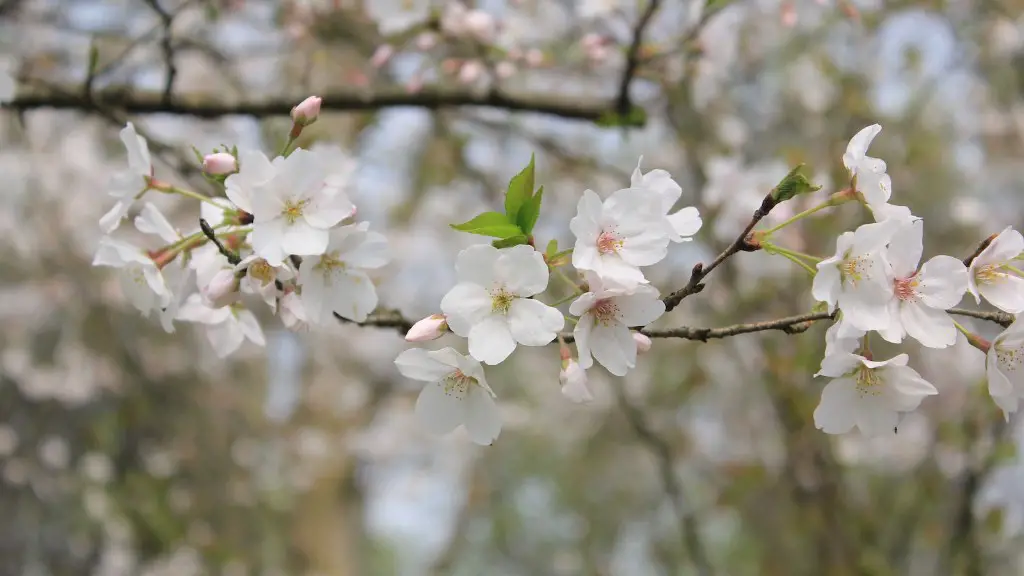When to Prune Cherry Plum Trees
Cherry plum trees are treasured for their sweet-tasting, juicy fruits. In order to ensure bountiful harvests every season, pruning is an important part of the annual maintenance regimen for these trees. The timing and technique of pruning will vary slightly depending on the cultivar and the climate in which the tree grows, but there are a few tips that should help gardeners get the best results.
The best time to prune the cherry plum tree is in late winter or early spring, when the tree is still dormant. During this period, the tree will not be actively growing and will be more receptive to pruning. When the weather gets warm and flowering begins, pruning should cease as it can interfere with flowering and reduce yields. Pruning after the flower buds have opened will also increase the risk of bacterial diseases.
When pruning a cherry plum tree, gardeners should use a set of sharp, clean pruning shears. Sharp blades will ensure a cleaner cut, which helps to minimize sap loss and the risk of infection. Gardeners should carefully remove any dead, diseased or damaged branches, as these can interfere with the tree’s health and reduce its yield.
Thinning is an important part of the pruning process, too. This involves the removal of entire branches to promote fruit development. By removing thickly clustered branches and leaves, the tree will be able to send more energy to the developing fruits, getting a larger yield. This should be done before the flowers open, as pruning after flowering will reduce fruit size and may even prevent it from ripening. It’s also important to note that cherry plum trees should not be pruned back by more than one-third of their height.
Finally, gardeners should take care not to damage the remaining branches or leaves when pruning. The pruning cuts should be made several inches from the trunk of the tree, avoiding the buds and leaves. By following these tips, gardeners can ensure their cherry plum trees remain healthy and productive.
Pruning for Shape and Size Control
While pruning cherry plum trees for shape and size control is not essential, it can be beneficial in some cases. Properly pruning the tree will help ensure that it maintains its desired shape, while also making it easier to harvest the fruits. When pruning for size and shape control, gardeners should take care not to prune too much, as this can stress the tree and reduce its productivity.
It’s important to remember that the tree’s shape naturally changes over time. Pruning the top of the tree more than the bottom will help keep the tree’s growth even and maintain its desired shape. When pruning, gardeners should take care to avoid a “lion’s tail” shape, which is what happens when the middle part of the tree is pruned back too much, leading to sparse and unbalanced growth.
The same steps should still be taken as when pruning for yield. Gardeners should use clean and sharp pruning tools, remove any dead or diseased branches and thin overcrowded branches before the flowers open. Thinning will help to open up the canopy and let in more light, which can help the flowers and fruits to develop more quickly.
Health and Strength of Cherry Plum Trees
Cherry plums are relatively hardy trees, but they are susceptible to a range of diseases and pests. Poor pruning techniques can increase the risk of these pests and diseases, so it’s important to follow the advice outlined above. Gardeners should also consider fertilizing their trees once a year to help them remain healthy and strong.
Fertilizing should usually be done in autumn, as this helps to strengthen the tree for the winter. There are a range of products available, but a fertilizer specifically tailored to cherry plum trees is ideal. This can be applied directly to the soil around the tree’s roots, ensuring the roots are well nourished and the tree remains strong.
In addition to pruning and fertilizing, gardeners should take care to water the tree regularly. Cherry plum trees need plenty of water to get the best yields, so they should be watered during dry spells and throughout the fruiting season. Always check the soil before watering, as overwatering can lead to yellowing leaves and is one of the biggest killers of cherry plum trees.
Harvesting and Storing Cherry Plums
Cherry plums should be harvested when the fruits are ripe and fully colored. Unlike some other fruits, cherry plums do not continue to ripen once picked, so gardeners should be sure not to pick them too early. It’s also important not to over-harvest, as this can reduce yields for the following year.
The fruits should be gently removed from the branches and stored in a cool, dry place. They should not be washed until just before eating, as this can reduce their shelf-life. The fruits can be stored for several weeks in the refrigerator, or they can be frozen if they won’t be consumed immediately.
Cherry plums can be enjoyed fresh, or they can be used in baking and preserves. They make a delicious addition to pies and jams, and their sweet flavor adds a unique twist to any meal.
Preventing and Treating Common Pests and Diseases
The most common pests of cherry plums include aphids, borers and scale insects. These pests can be treated by pruning off affected branches and spraying the tree with an insecticidal soap solution. However, if the infestation is severe, then a professional pest control company may be needed.
Common diseases of cherry plums include leaf curl, powdery mildew and dieback. These can be prevented by ensuring proper pruning techniques and by providing adequate nutrition and water. If the tree is affected by a disease, it’s best to seek professional advice.
By following the advice outlined in this article, gardeners should be able to get the best yields from their cherry plum trees. Pruning and fertilizing properly, combined with regular watering, will help to ensure the tree stays healthy and produces quality fruits every season.
Holistic Plants Care for Healthy Harvest
Aside from the pruning, fertilizing and pest control efforts of the gardeners, one of the best ways to get a healthy harvest of cherry plums is by taking care of the plants holistically. The idea here is rooted in the philosophy of permaculture, which puts plants, animals and the environment at the center of its practice. As such, permaculture focuses on fostering an environment where all elements can coexist as a system.
The permaculture approach to horticulture includes implementing organic gardening methods, companion planting and creating beneficial habitat for beneficial insects and animals. This way, gardeners can create an effectively balanced and sustainable system that, in turn, helps to ensure healthy plants and a higher yield of cherry plums.
Organic gardening focuses on using only natural, non-toxic methods. This includes composting, mulching, hand weeding and applying natural compost and mulch to help keep soils healthy. Companion planting, meanwhile, takes advantage of the beneficial relationship between certain plants and helps to improve the health and yield of nearby plants.
By incorporating these holistic practices into their gardening efforts, gardeners can ensure their cherry plums are healthy and productive every season. With proper pruning, fertilizing and holistic plants care, gardeners can look forward to a juicy harvest of these delicious fruits each and every season.
Conclusion
Pruning is an important part of caring for cherry plums, and should be done in late winter or early spring. Gardeners should use clean, sharp pruning shears, remove any dead or damaged branches and thin overcrowded branches to allow more light and energy to reach the developing fruits. Pruning for size and shape control can also be done, as long as gardeners take care not to prune too much. Additionally, cherry plums should be fertilized and watered regularly to ensure they are healthy and strong.
Finally, holistic plants care, including organic gardening and companion planting, can help to improve the health and yield of the trees. By following the advice outlined in this article, gardeners should be able to get the best yields from their cherry plum trees.




